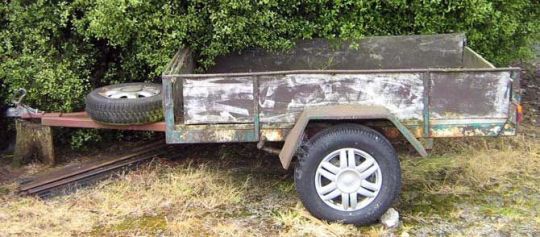Buying a Second Hand Trailer

If you are going it alone to check out a second hand trailer, take a pair of overalls, torch, a car jack and small hammer with you and get under the trailer and give it a good check out.
The following is a checklist of some of the more important things to look at before purchasing a second hand trailer –
Overall condition – a quick glance over the trailer will give you some idea how worn and treated the trailer has been; it is normal to find dings and dents in the panel work and the odd bent tie rail or guard. Paintwork and galvanizing may be compromised in a couple of places, and the condition of the deck, depending on the material used and the trailers age, will give away whether the trailer has been looked after or abused and overloaded.
Drawbar – any damage, bend or twist in the drawbar can be cause for concern: the strength of the drawbar may be compromised and the trailer may not tow true, which in turn can cause trailer sway and worn tyres, or in the worst case scenario - an accident.
Coupling wear – hook the trailer onto your tow vehicle, making sure that the coupling and towball are matched sizes, and give the drawbar a good jiggle side to side and up and down and see if there is any play within the coupling. On a heavy trailer where this is not possible without doing yourself an injury, take a new towball with you and insert it into the coupling head.
Deck condition – this is wholly dependent on the type of deck material used, but if it is a steel or alloy deck, look for corrosion, broken welds and rivets/fasteners. Get on the trailer and have a good jump around to determine if the deck is loose in any areas. This may also help indicate loose or poor suspension. With a plywood or timber deck, again check for any damage, loose fasteners, delaminating and rot.
Tyres – check all tyres are matched sizes and check the condition of the tread. Uneven wear across the width of the tyre will indicate a problem with wheel misalignment, which could be one of several issues (axle misalignment, faulty hubs/bearings or previous overloading of the trailer).
Wheel Bearings - Jack the trailer up and spin the wheels. Listen for any rumbling noises or rough rotation which could indicate worn wheel bearings. With the trailer jacked up, firmly grasp each tyre and check for movement side to side as well as top to bottom. If any movement is felt, the bearing will need to be re-seated.
Tailgates – operate all the latches and tailgates and make sure all is working as it should. Check the hinges for excess wear and any cracked or broken welds. Also check that the tailgates are straight and close easily and securely.
Guards – Check that the guards are securely attached to the trailer and there is minimal damage/corrosion. Guards normally are the most abused things on a trailer, from taking the hard knocks to being used for seats, steps and as mobile workbenches.
Tie hooks – check the condition of the tie hooks and tie rails for wear and how securely they are attached to the trailer, and also importantly, that there enough of them and that they are tough enough to do the jobs you need the trailer for.
Lights – Hook up your vehicle and with assistance, check all the lights are working correctly. Make sure the lights are matching and are in good condition. Check for any water or impact damage and also for any lens fading from sun exposure. Give them all a wiggle to make sure they are secure.
Under chassis – chuck your overalls on and take a torch and your small hammer and crawl under the trailer (chock the wheels first). Check every part of the chassis for any signs of damage, broken welds, and corrosion. Give the chassis a tap with the hammer and listen to the sound coming back to you. Normally if the noise is a good sharp steel on steel noise, the underlying condition of the steel is good. If the sound is dull and non-resonating there is a good chance of corrosion within. Bubbling paint or discoloured galvanizing are good signs of corrosion. Look especially around where the drawbar is attached to the chassis and the suspension. Check the condition of the axles, springs and spring hangers and slippers for any damage or corrosion. Leaf springs will normally have some signs of dry powdery rust around the leaves but if the outer edges of the springs are tapering the trailer has had a lot of use and has possibly been overloaded. Cracked springs are also an indicator of this. With torsion suspension, the angle of the torsion bar with the trailer unloaded will give some indication of the condition of the rubber inserts. Check the wiring for the lights if possible and look for any fraying or rubbing against the chassis, loose cables or poorly connected junctions.
Be realistic when deciding whether you want to undertake any major repairs on a second hand trailer (e.g. - replacing a bent drawbar or corrosion removal) as the expense and time may far exceed the initial price of the trailer.